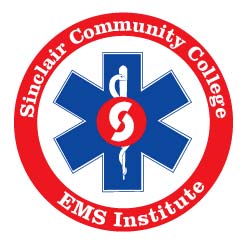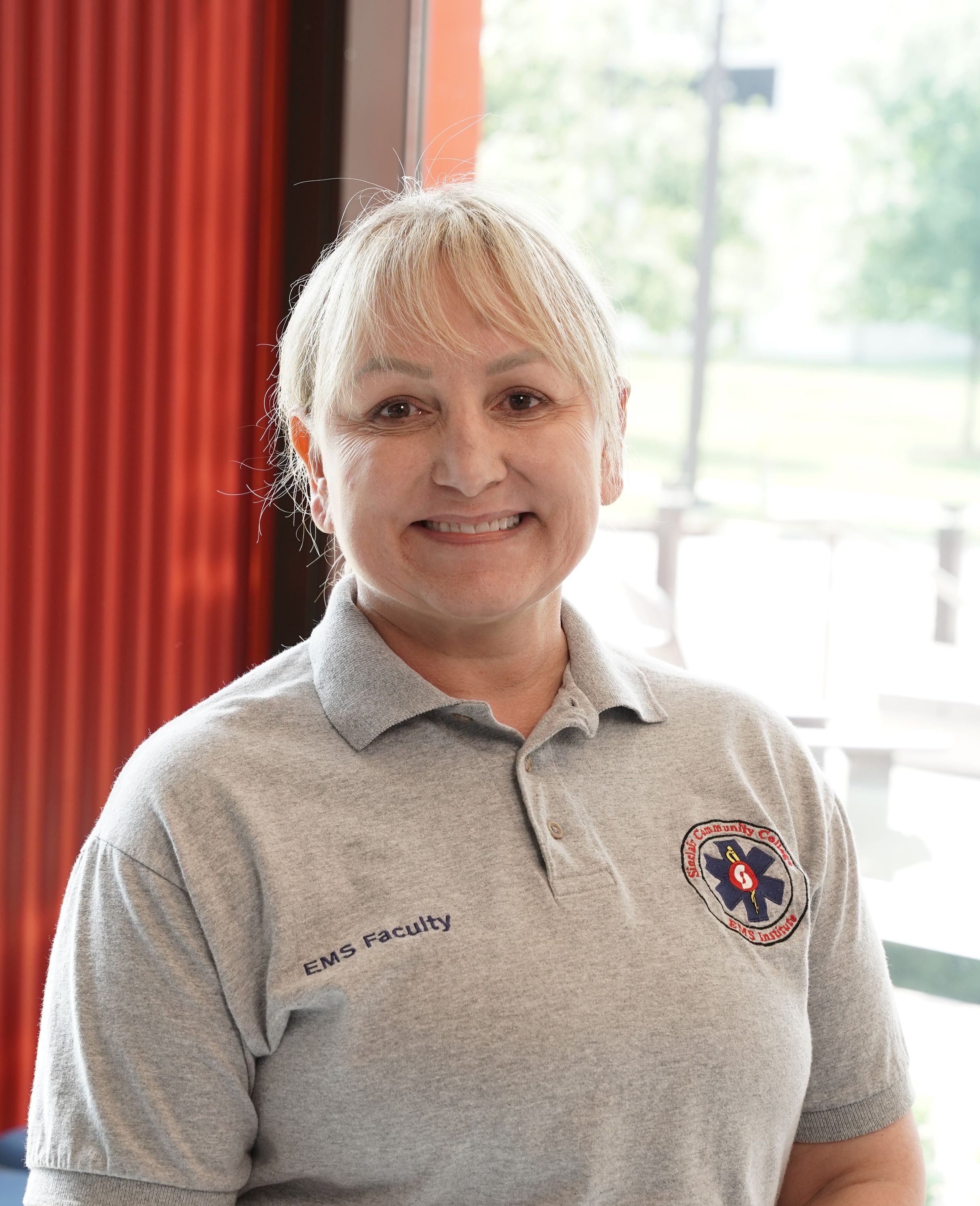Emergency Medical Services
Ready to start a new and exciting career as an Emergency Medical Technician (EMT) or Paramedic?
With this program, students acquire the skills to become Emergency Medical Technicians (EMT) and Paramedics who provide out-of-hospital care to the critically ill and injured. EMT's and Paramedics must be capable of functioning with authority and good judgment in a variety of circumstances under difficult and stressful conditions, and must be caring persons with the desire to help others. In addition to the physical demands of the job, applicants may need to deal with challenging emotional, ethical, and or spiritual issues.
P: 937-512-5338
F: 937-512-5175

What do Emergency Medical Service (EMS) providers do?
EMS providers will “size-up” the scene to determine that the scene is safe, the mechanism of injury or nature of illness, total number of patients and to request additional help if necessary. Determines the nature and extent of illness or injury and establishes priority for required emergency care. Based on assessment findings, EMS providers render emergency medical care to adult, infant and child, medical and trauma patients. Duties include but are not limited to, opening and maintaining an airway, ventilating patients, and cardiopulmonary resuscitation, including use of automated external defibrillators. Provide out-of-hospital emergency medical care of simple and multiple system trauma such as controlling hemorrhage, treatment of shock, bandaging wounds, and immobilization of painful, swollen, or deformed extremities. Patients will be found in all types of environments: homes, care facilities, traffic accidents, building collapse, fire scenes, etc.
.jpg)
Why major in Emergency Medical Services?
Upon the completion of the the Emergency Medical Technician/Paramedic program and obtaining a state licensure, the Emergency Medical Technician (EMT) or Paramedic is typically employed with fire departments, private ambulance companies, hospitals, and within the industry.
Licensure also allows individuals to have higher earnings potential and responsibilities within the fire service or expand opportunities that exist in the allied health field. Persons working full time as Firefighter/Paramedic will increase wages significantly.
The Associate degree, though not required for immediate employment, will best serve the student who is looking to advance once hired.
This area of study might be for you if :
- Like caring for others
- Possess rapid problem solving abilities
- Enjoy teamwork
Information:
 Available Programs
Available Programs
For program specific information click on the program below:
Emergency Medical Responders (EMR's) are personnel, typically not found within the healthcare setting, who as part of their job have to care for the sick and injured before an ambulance arrives. These individuals are educated to stabilize patients using very limited amounts of medical equipment. Police officers, safety officers, and others who would be expected to arrive at the scene of an injury or illness before the ambulance could benefit from this education. Students will use lecture and laboratory environments to learn the skills needed to care for patients. For more information, contact the EMS department at (937) 512-5338 for an entrance application packet. Note: For students under age 18 there may be restrictions on participating in certain Health Sciences programs. Any student under age 18 must contact the program director/department chair to discuss whether he or she may enroll.
View Full Program Details
Emergency Medical Technicians (EMTs) are essential members of the health care team who provide time sensitive care to patients. These individuals take the emergency department to people's homes, to highways and to other remote locations. EMTs bring life-saving equipment and knowledge to bear in an effort to reduce patient’s suffering and to save lives. Students will use lecture, laboratory and real world exposure to emergencies to learn the skills needed to care for the sick and injured in the out-of-hospital environment. The program is offered to provide students with variability and flexibility in scheduling. For more information, contact the EMS department at 937-512-5338 for an entrance application packet. Note: For students under age 18 there may be restrictions on participating in certain Health Sciences programs. Any student under age 18 must contact the program director/department chair to discuss whether he or she may enroll.
View Full Program Details
Important Information about Health Sciences Programs: The Health Sciences (HS) Programs consist of open enrollment courses (general education and division specific) and program specific courses with limited enrollment. The open enrollment courses may be taken prior to entry into the limited enrollment courses. To qualify for entry to limited enrollment courses, please see the program specific information packet located on each HS program's webpage.
It is very important that you meet with an Academic Advisor by calling 937-512-3700, or visiting Building 10, Room 301, to make sure you are scheduling the correct classes for your program choices. They can also direct you to financial services for any information you require about finances.
Accreditation
State Accreditation number 326. State accreditation expiration is 03/31/2019. For further information on this program’s accreditation, please contact the Ohio Division of EMS, 1-800-233-0785. Mailing address is:
Ohio Emergency Medical Services
P.O. Box 182073
1970 West Broad Street
Columbus, Ohio 43218-2073
The Sinclair Community College is accredited by the Commission on Accreditation of Allied Health Education Programs (www.caahep.org) upon the recommendation of the Committee on Accreditation of Educational Programs for the Emergency Medical Services Professions (CoAEMSP).
Commission on Accreditation of Allied Health Education Programs
727-210-2350
To contact CoAEMSP:
214-703-8445
CoAEMSP Annual Report for 2022 Graduates.
Results based on paramedic graduate completion date, not cohort start date.
Retention Rates = 92.5% Attrition Rate = 7.5%
NREMT Pass Rate = 90.4% (Includes only Tests 1-3) Job Placement = 93.2%
Graduate Survey Results for 2022 Graduates (n=65/68)
- COGNITIVE: Do you meet the competencies of an entry-level Paramedic in the COGNITIVE (knowledge) domain? = 99%
- PSYCHOMOTOR: Do you meet the competencies of an entry-level Paramedic in the Psychomotor (skills) domain? = 99%
- AFFECTIVE: Do you meet the competencies of an entry-level Paramedic in the Affective (behavior) domain? = 99%
- Are you satisfied with your educational preparation? = 98%
Employer Survey Results for 2022 Graduates (n=55/68)
- COGNITIVE: Do you meet the competencies of an entry-level Paramedic in the COGNITIVE (knowledge) domain? = 96%
- PSYCHOMOTOR: Do you meet the competencies of an entry-level Paramedic in the Psychomotor (skills) domain? = 96%
- AFFECTIVE: Do you meet the competencies of an entry-level Paramedic in the Affective (behavior) domain? = 98%
- Are you satisfied with your educational preparation? = 98%
Pass Rates
Paramedic Aggregate Pass Rates by Starting Cohort
| Paramedic Starting Term | Aggregate Pass Rate |
|---|---|
| Fall 2012 | 94% |
| Spring 2013 | 93% |
| Fall 2013 | 97% |
| Spring 2014 | 92% |
| Fall 2014 | 92% |
| Spring 2015 | 100% |
| Fall 2015 | 100% |
| Spring 2016 | 100% |
| Fall 2016 | 90% |
| Spring 2017 | 94% |
| Fall 2017 | 97% |
| Spring 2018 | 92% |
| Fall 2018 - DFD | 100% |
| Fall 2018 | 96% |
| Spring 2019 | 96% |
| Fall 2019 - DFD | 100% |
| Fall 2019 | 89% |
| Spring 2020 | 100% |
| Fall 2020 | 86% |
| Spring 2021 | 100% |
| Fall 2021 | 90% |
| Spring 2022 | 94% |
- Last Updated: 12/11/2023
- Overall Aggregate Pass Rate = 94%
- National Comparison = 90%
EMT Aggregate Pass Rates by Starting Cohort
| EMT Starting Term | Aggregate Pass Rate |
|---|---|
| Spring: 2015 | 87% |
| Summer: 2015 | 85% |
| Fall: 2015 | 83% |
| Spring: 2016 | 97% |
| Summer: 2016 | 86% |
| Fall: 2016 | 93% |
| Spring: 2017 | 84% |
| Summer: 2017 | 89% |
| Fall: 2017 | 80% |
| Spring: 2018 | 85% |
| Summer: 2018 | 92% |
| Fall: 2018 | 93% |
| Spring: 2019 | 87% |
| Summer: 2019 | 92% |
| Fall: 2019 | 81% |
| Spring: 2020 | 86% |
| Summer: 2020 | 94% |
| Fall: 2020 | 90% |
| Spring: 2021 | 86% |
| Summer: 2021 | 84% |
| Fall: 2021 | 94% |
| Spring: 2022 | 89% |
| Summer: 2022 | 88% |
| Fall: 2022 | 89% |
| Spring: 2023 | 86% |
| Summer: 2023 | 89% |
- Last Updated: 12/11/2023
- Overall Aggregate Pass Rate = 88%
- National Comparison = 81%
EMR Aggregate Pass Rates by Completion Semester
| EMR Starting Term | Aggregate Pass Rate |
|---|---|
| Spring 2014 | 100% |
| Spring: 2015 | 100% |
| Spring: 2016 | 67% |
| Spring: 2017 | 90% |
| Spring: 2018 | 86% |
| Summer: 2018 | 86% |
| Spring: 2019 | No students tested for NREMT |
| Spring: 2020 | No students tested for NREMT |
| Spring: 2021 | No courses offered |
| Spring: 2022 | 100% |
| Spring: 2023 | No course offered |
- Last Updated 12/11/2023
- Note – No one tested from Spring 2019 or Spring 2020
- Overall Aggregate Pass Rate = 88%
- National Comparison = 75%
Meet Our Full-Time Faculty!
Dominika Kozlowski
EMS Full-Time Faculty
Mike Oaster
EMS Full-Time Faculty
I graduated with an M.B.A. in Health Care Management from Indiana Wesleyan University and a B.S. in Elementary Education from West Chester University. I also earned my paramedic credentials from St. Joseph Hospital Paramedic Institute in Lancaster, PA. Over the years, I have cultivated an esteemed career, predominantly focused on medical education and management. Starting as the Program Director at the Albert Einstein Medical Center in Philadelphia, I took on pivotal roles in paramedic and EMT courses. I then served at Harrisburg Area Community College in Lancaster, PA, as an EMS Instructor. My dedication to education continued at Sinclair Community College in Dayton, OH, where I am currently a Professor of EMS. My contributions here, from developing curricula to mentoring new faculty, have been recognized through multiple accolades, including the Meritorious Teaching Award received consecutively from 2005 to 2023.
However, my expertise isn't limited to the classroom. My managerial acumen shines through in my roles at various emergency medical service organizations. Serving as the Director of Operations at White Rose Ambulance, I oversaw a bustling operation handling over 25,000 calls per year. My responsibilities spanned from the day-to-day management to employee performance development and public relations. Similar impactful roles were played at the Lancaster EMS Association, serving as Administrative Supervisor after starting there as a Paramedic.
Beyond my full-time positions, I am actively affiliated with the Sinclair Community College EMS Department's and Fairmont High School's Fire Science Advisory Boards. Internationally, I left my mark at the Narenthorn Center in Thailand, dedicating three summers to impart EMS and Instructor courses across the nation. I also contributed as a textbook reviewer for the National Association of EMS Educator’s Foundation of Education. All these experiences have honed my ability to foster a diverse, equitable, and inclusive learning environment, cementing my reputation as an influential figure in EMS education and management.

Jim Simonson
EMS Full-Time Faculty
I am a native of the Chicago area and have been a professor at Sinclair since 2003, serving as the departmental clinical coordinator and lecturer, teaching the paramedic program. I worked briefly as a firefighter/paramedic for Riverside Fire Department and then held the role of paramedic/Senior Paramedic with the Dayton Fire Department for 12 years. I also serve as a paramedic with the Ohio-5 Disaster Medical Assistance Team under the US Department of Health and Human Services. From 2013 through 2015, I served Sinclair as an Associate Director for Completion by Design through the Bill and Melinda Gates Foundation, working closely with all areas of student services and information technology with the goal of increasing success for first-generation, minority, and under-resourced students.
I hold a PhD in Educational Leadership from Northcentral University (now National University). I also have an extensive musical background with a Master and Bachelor degree in music from the University of Kansas and Eastern Illinois University respectively. I was a former active duty member of the Air Force Band of Flight and am a professional horn player. Currently, I play with the Ohio Valley Symphony, Mason Symphony, Springboro Wind Symphony, Sinclair Wind Symphony and often substitute with other organizations. Me and my wife, Tammy, have a Yorkshire Terrier named Riley and live in the Springboro area.

Chuck Sowerbrower
EMS Chairperson
I began my career in EMS in West Chester, PA in 1986. Worked at a volunteer EMS and private ambulance agency and as I pursued my paramedic education. I became a paramedic in 1989. I worked as a paramedic, EMS educator and EMS supervisor at a hospital based system. I continued my education until I obtained my Master’s Degree in Education in 1999.
I moved to Ohio and became the chairperson of EMS education at Sinclair in Jan of 1999. While at Sinclair I have taught paramedic, assisted in the creation of our EMS degree, oversaw three major curricular updates, and led the program as it became nationally accredited in 2012. I continue to practice as a paramedic working at Harrison Township Fire department. 2024 will mark my 24th year at Harrison.

Katie Wagner
EMS Full-Time Faculty
I graduated with a Bachelor of Liberal Studies from Bowling Green State University. During that time, I also completed training as a Domestic Violence Advocate. I earned my Emergency Medical Technician, Paramedic and Fire 1 certifications through Sinclair Community College. I served in the field as a Fire Fighter/Paramedic for 10 years. My time as a Fire Fighter/Paramedic included working at Jefferson Township Fire Department, where I earned the rank of Lieutenant. During that time I also worked for Ohio Ambulance Solutions, a private ambulance company based in Cincinnati, Ohio and as an Emergency Department Technician at Southview Hospital.
I earned my Emergency Medical Services Instructor certification through Sinclair Community College Summer of 2021, and joined the EMS Department as Adjunct Faculty in August of 2021. I have been teaching as a Full-Time Faculty member with the EMS Department since January 2023.
.jpg)
William R. Marriott
Medical Director, Premier Health
I got my start in EMS as an EMT at Cedarville University in 1982, followed by being a paramedic for the Dayton Fire Department. After graduating from the Wright State University Boonshoft School of Medicine in 1991, I stayed at WSU for emergency medicine residency training. Upon completion, I began practice at Miami Valley Hospital in 1994. I now serve as the Medical Director for DFD, Dayton MMRS, the Greater Miami Valley EMS council, and numerous other agencies.
I have been a leader in expanding EMS protocols, and have pushed to increase paramedic autonomy. I have chaired the Region 3 Regional Physician's Advisory Board (RPAB) for EMS for over twenty years and served as a physician for the Kettering Regional SWAT team. I am the medical team manager for the OH-TF-1 Urban Search and Rescue, and was deployed to New York on 9/11/2001, to Hurrican Rita, the Champlain Towers Collapse, and other incidents. I am board certified in emergency medicine, and when subspecialty certification in EMS became available through the American Board of Emergency Mecicine in 2013, I was part of the first group to obtain this credential.
In 2023, I became the medical director for CareFlight Air and Mobile, and have been the mecial director and the adjunct faculty member for the Sinclair Community College Paramedic program since 2018. I currently live in Centerville with my wife Lynda. We have three chikdrens and six gradnchildren.


